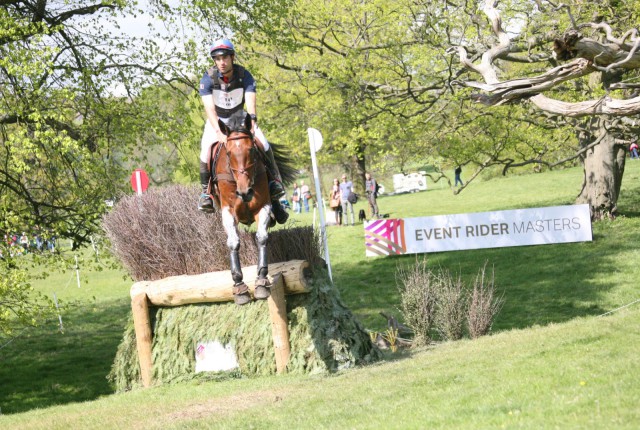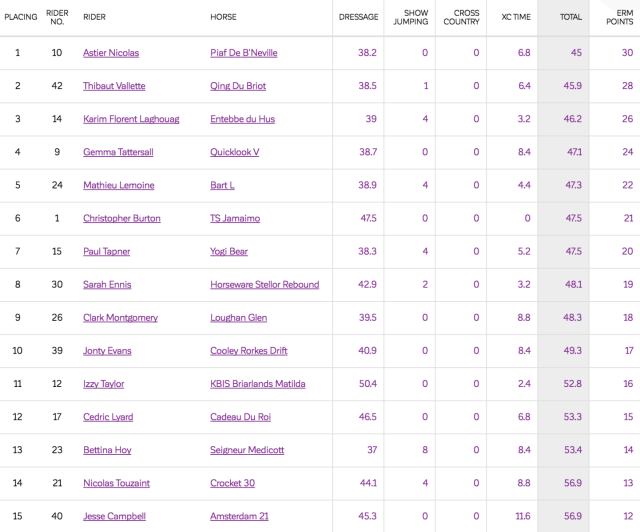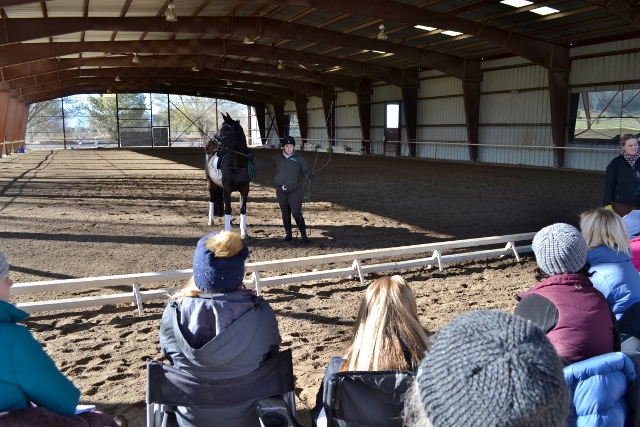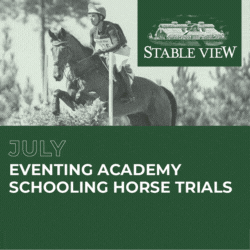 Sara Mittleider and Harry Houdini. Photo by Samantha Clark.
Sara Mittleider and Harry Houdini. Photo by Samantha Clark.
When you follow Sara Mittleider’s story from the beginning to now, it’s almost impossible to believe that so much could happen to a person in one lifetime, let alone someone who is only 30 years old. At 13, Sara purchased an off-track Thoroughbred for $300 whom she called El Primero, and the pair would catapult up the levels to become a world class team.
In 2005 at the age of 19, Sara was making her four-star debut at Rolex where she and “Tony” finished 14th. They also finished in the top 20 in 2006, 2007, and 2010, and Sara was the first to win the Reeves Trophy for highest placed young rider three times. In 2006, she and Tony were traveling alternates for the World Equestrian Games in Aachen.
Tony was retired from the upper levels and passed away just last year, but he gave a lifetime of experiences to the Mittleider family, who have made their Rock Hollow Farm, in Kuna, Idaho, one of the premiere eventing facilities in the western United States.
Sara is now incredibly busy coaching, competing, bringing along a string of talented young horses, and this past year was given the ride on Linda and Terry Paine’s Gin & Juice. We caught up with Sara between spring events, and she graciously agreed to answer a few questions.
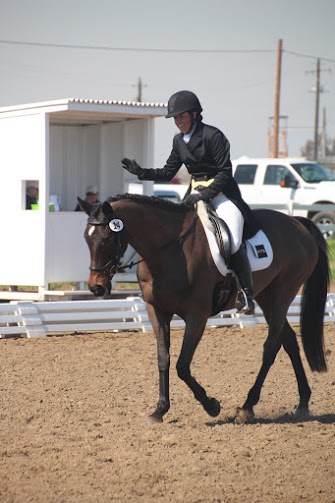
Sara and Gin and Juice. Photo courtesy of Sarah Moseley.
EN: You ride a lot of horses at many levels. How do you stay organized and focused over a show weekend?
Sara: “Team work. Having nine or more horses at an event requires a good plan and a system that we map out before each show. My dad Gary, my husband Attila, and myself will share the coaching duties for our students competing. That is a big help and relieves the pressure off one person trying to be everywhere.
“All of our Team at Mittleider Eventing pitches in with the care and management of the horses through the weekend. My mom Brenda oversees a lot of what goes on at the barn and camp and is there to problem-solve anything that may pop up.”
EN: Tell us about your Trakehner breeding stallion, Semper Fidelis. What are your career goals for him, and how do you think his genes will contribute to eventing?
Sara: “Semper Fidelis, also known as Snapper, is my dad’s horse. He came to us from his breeder in Texas, Kim Hunter. He wasn’t quite 2 when he arrived. My dad started him and has done all the work with him throughout his training. He is now 7 and has some Prelims under his belt. This year’s goal for him is a CCI*.
“He has done a little bit of breeding up to this point. We currently have three of his offspring on our farm. Two are three-year-olds now and one 2-year-old. All are out of three very different mares. Snapper has a stellar disposition, and he seems to really pass that on to his babies and a work ethic. That is really what we are looking for in our program. We want athletic horses, but we really want trainable ones.”
EN: You’re also quite involved with importing warmbloods from Hungary and make regular buying trips to Europe each year. What attracts you to horses in this region?
Sara: “The horses coming in from Hungary aren’t necessarily a Hungarian breed. Predominantly, they have been of modern European bloodlines of Hanoverian, Holsteiner and Selle Francais. We have been greatly impressed with the dispositions on all of the horses that have been brought over, as well as their aptitude to transitioning from show jumping to eventing.
“So far, we have found horses for pros, young riders, adult amateurs and kids moving from ponies to their first horse. Attila will be making a trip over there in May on a talent search for the next group.”

Sara and La Paz. Photo by Chesna Klimek
EN: Most eventers probably wouldn’t consider Idaho as a hub for the sport. Do you think that’s a fair perception, and why is Rock Hollow Farm so special to you and your family?
Sara: “Idaho is very much horse country, but it is still mostly ranching and the western disciplines, but dressage and eventing are picking up. I don’t mind it being a little off the traditional path of where to set up shop. You can really concentrate on your own system and not get swept up in what everyone else is doing.
“Our farm is quite special to me. It really has everything you could want in an eventing facility. We have stalls, pasture, pens, an indoor, a large outdoor, grass jump field, a slew of cross country fences with a big bank complex and two water jumps, a gallop track, and after a 30-minute drive, you’re out in the foothills for hill work. We are always working to improve on things as well.”
EN: Tell us how you’re getting on with Gin & Juice.
Sara: “I feel like Ginny and I are starting to become a team. It really does take time to develop a feel for any horse, much less one as established as her. I’ve been riding her for nine months now, and we are both getting comfortable with each other, and we have an idea of what to expect from the other. I genuinely like her, and she is always meeting me at the gate from her field demanding to be the first ride in the morning.
“We had a couple unexpected bumps in the road this spring, but I’m hoping we have sorted that out. We are still figuring out a summer/fall plan for her.”
EN: What other horses in your string have you excited?
Sara: “I have a few young horses that I’m currently working up the levels. The furthest along of that bunch is La Paz, a 6-year-old Hungarian Sport Horse, owned by the Solon Family. “Muki” is a very talented horse to be sitting on. He is very capable in all three phases, and he has a spunky attitude to go with his talent.
“My other horses are 5 and younger and still gaining experience at the lower levels. I am very fortunate to have the support and clientele that I have. They’re a great group of people, and I’m riding some very good quality horses, and it’s just fun to get to do this with them.”

Sara Mittleider and El Primero at Rolex. Photo by Silvio Wolf Busch.
EN: If you could take a spin on any horse past or present, who would it be?
Sara: “Honestly, there’s no other horse I would love to ride more than my late El Primero. He was a true master of a cross country horse. Riding him on any course is beyond what words can describe, even to this day.”
EN: There’s always talk of the sport evolving — getting safer, getting more viewer friendly, increasing participation. As a lifelong eventer, what do you think needs to change, and what shouldn’t change?
Sara: “I feel like our sport is trying very hard to stay relevant. The one thing I hope that does not change is the camaraderie in our sport.”
EN: What are your goals for the 2016 season and beyond?
Sara: “My goal for 2016, and every year, is to keep working to develop my horses up to the four-star level. Other than Gin & Juice, my horses are young. I just want to keep building them up, keep my system evolving, and learning to give myself the best chance of having a sound and educated partner for the duration of their career.”
EN: What advice would you give to someone aspiring to ride at the upper levels?
Sara: “There are several tips of advice I can’t stress enough for aspiring riders of any age. The biggest one is: Don’t skip steps. This is a sport based on a training system of longevity. It takes years to educate and create a fitness level to compete successfully at the top of this game — not just for your horse, but you as well.
“It’s great to have goals and to have a timeline you’d like to achieve them in. It is also very common for that plan A to fall apart. Be flexible, willing and brave enough to accept if you or your horse are not ready, to try again another day.”
Many thanks to Sara for taking the time to speak with us! Go Eventing.












